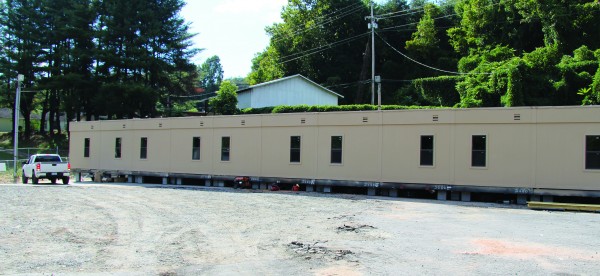
In a few weeks, the Analenisgi Program will move to a modular unit at the old Mountain Federal Credit Union site behind the BIA Cherokee Agency and will re-open as the Analenisgi Recovery Center. (SCOTT MCKIE B.P./One Feather)
By SCOTT MCKIE B.P.
ONE FEATHER STAFF
In a few weeks, the Analenisgi Program will move to a modular unit at the old Mountain Federal Credit Union site behind the BIA Cherokee Agency and will re-open as the Analenisgi Recovery Center. The program, under the auspices of the Cherokee Indian Hospital Authority since October 2013, is currently housed behind the Tsali Care Center in the Birdtown Community.
“We are physically moving our staff on Oct. 16, and we will be opening to our patients on Monday, Oct. 19,” said Kristi Case, MPA, Recovery Services manager.
Doug Trantham, MSW, LCSW, Behavioral Health director, said opening the Recovery Center is one of 15 recommendations a Task Force made to Tribal Council in dealing with mental health and substance abuse. “We’re really excited to be able to open that in this new space.”
The modular unit the program will move into is a temporary home with the eventual home being the Cherokee Indian Hospital. “There will be a process initiated to repurpose the old hospital for Behavioral Health and some other hospital programs,” said Trantham. “That’s exciting because we’ll be right on the same campus as the hospital, but we’re also going to have our own space. I think that will be an ideal situation.”
That is still a few years off said Trantham who related that the temporary home is a much better fit than the current place. “The new location is very comparable in size to the old one, but it’s laid out much better. It’s laid out specifically to accommodate the services and activities that we do.”
He said parking will be much better at the new location. “Parking is completely inadequate at Tsali Care where we’re at so that’s been a concern. We have as many as 25 people at a time coming to see us, including our staff, so parking is going to be much better.”
Trantham said the waiting room will also be a big improvement at the new site. “Our waiting room at Analenisgi now is really small. It’s not unusual to have a dozen or more people waiting in there, and it’s just not a comfortable environment, and there’s no separation between child and family services and adult services. We just have one little waiting room.”
“In the new one, we’ll have a typical reception area with a wide window, room for two staff to be here, so we’ll be able to meet and greet and respond to people better.”
Case added, “It has also allowed some expansion. We’re going to be adding an adult therapist position and some additional space for our doctors. It’s fully accommodating for all of our staff at this point.”
Trantham said the Recovery Center is just the first part in a comprehensive treatment plan for the Tribe. The Snowbird Residential Treatment Facility, which will have 20 beds (10 male, 10 female), is now under development with a preliminary open date of Fall 2016.
He said one of the biggest challenges with having to send people away to residential treatment facilities is what to do after treatment. “I’ve had people tell me, ‘I can’t go back to Cherokee. I can never go back to Cherokee.’ And, I just think that’s awful to hear that because this is their home.”
Trantham said a part of the plan is to build a Men’s Home and a Women’s Home where people can live for as much as six to nine months after they live a treatment facility that will be a safe and drug-free place for them.
“It’s not just about building a treatment center,” he commented. “What we want to do is create a recovery community. We want to create a community in Cherokee that supports people achieving and maintaining sobriety and wellness – a well and balanced life.”
While in the post-treatment homes, people will be able to receive help in various areas including: employment services, GED classes, learning how to access tribal programs, and more.
“Our goal is to have them in treatment for a year because evidence shows that people who stay engaged in treatment for a year have a better prognosis for long-term recovery.”
Funding of programs is always a discussion and Trantham related, “The Analenisgi services, when it was operated by the Tribe, was substantially funded by the Tribe. But, many of those services are billable to Medicaid, and so, if you bill Medicaid you have to meet Medicaid requirements and Analenisgi was historically not meeting Medicaid requirements and was not billing for the services.”
He said that within six months of taking his current position, he worked to get the essential elements in place so that billing of Medicaid could occur, and the program began doing so in July 2014. “That’s important for the Tribe because if Medicaid pays for the service, the Tribe doesn’t need to. This helps it not be nearly as expensive for the Tribe as it otherwise would be.”
Info: Analenisgi Recovery Center, 375 Sequoyah Trail, Cherokee, 497-9163 ext. 7550




